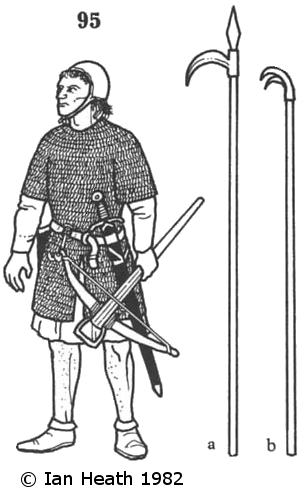
Create an Amazon Business Account
ITALIAN SEAMAN, 12th-13th CENTURIES
 An extract from Armies of Feudal Europe 1066-1300
An extract from Armies of Feudal Europe 1066-1300by Ian Heath

 An extract from Armies of Feudal Europe 1066-1300
An extract from Armies of Feudal Europe 1066-130095. ITALIAN SEAMAN, 12th-13th CENTURIES
By the 11th century all Italian seamen, whether oarsmen, sailors or marines, generally wore body-armour in wartime and it is referred to in many sources throughout this period. There were obvious disadvantages, though: its weight was undoubtedly responsible for the large numbers of men drowned in naval battles, while it must have been exhausting to row any great distance while wearing armour - certainly the Genoese credited their decisive victory over the Pisans at Meloria in 1284 in part at least to the fact that the latter were exhausted alter rowing fully armoured in the summer heat while the Genoese themselves had stripped so were fresh for the battle. However, since seamen had to supply their own equipment lighter forms of armour, including leather helmets and jerkins, also appeared.
The principal weapon of the marines was the crossbow; others were bellatores, meaning they carried swords, spears, axes and the like. Oarsmen were similarly armed, the equipment of 13th century Venetians including sword, dagger, spear or javelin, helmet or cap, buckler and body-armour. A Genoese law of 1313, undoubtedly merely confirming earlier practice, lists seamen's equipment as including helmets, mail corslets, javelins, maces and swords amongst other weapons. Generally officers and higher-paid seamen were expected to have better armour and more weapons. Various other arms are recorded for shipboard use including assorted long-handled hooks and blades for cutting rigging, smashing oars, and killing at a distance. Some 13th century illustrations of sea fights show men being dragged from the decks of ships by such weapons as 95a and b.
The arming-cap appears to have been worn by the Venetians at least as early as the Fourth Crusade and is probably the woollen cap referred to in a 13th century description of dress. The rest of the seaman's costume consisted of linen or cotton tunic and trousers (silk in the case of officers) sometimes perhaps in uniform colours to match the colours the ships were painted. However, contemporary illustrations often show seamen barelegged and sometimes barefoot.
This figure is based on sketches in Matthew Paris' 'Chronica Majora'. Further figures in the same source are shown with heater shields, helmets, mail coifs, axes, maces, flails and staff-slings. Yet others, principally representing French or English seamen, are either unarmoured or wear only quilted or leather armour and sometimes a helmet.
[Based on Sea Battle between the Pisans and Genoese, 1241, Chronica Majora by Matthew Paris]